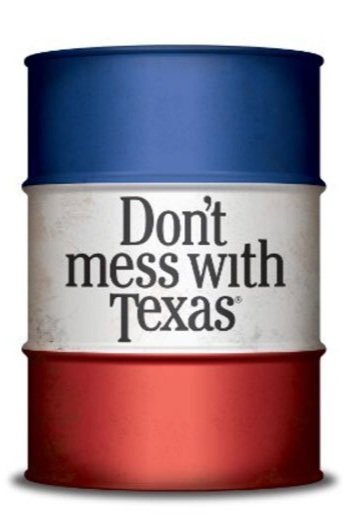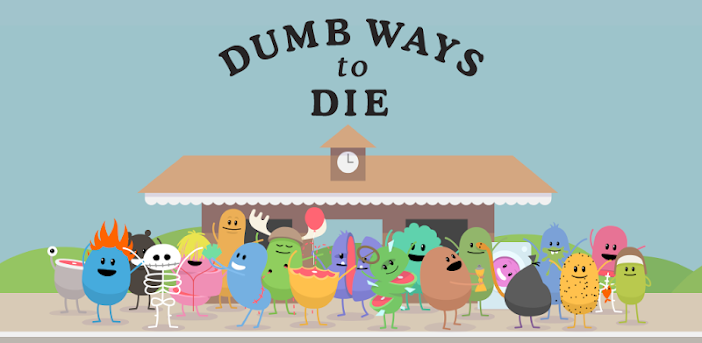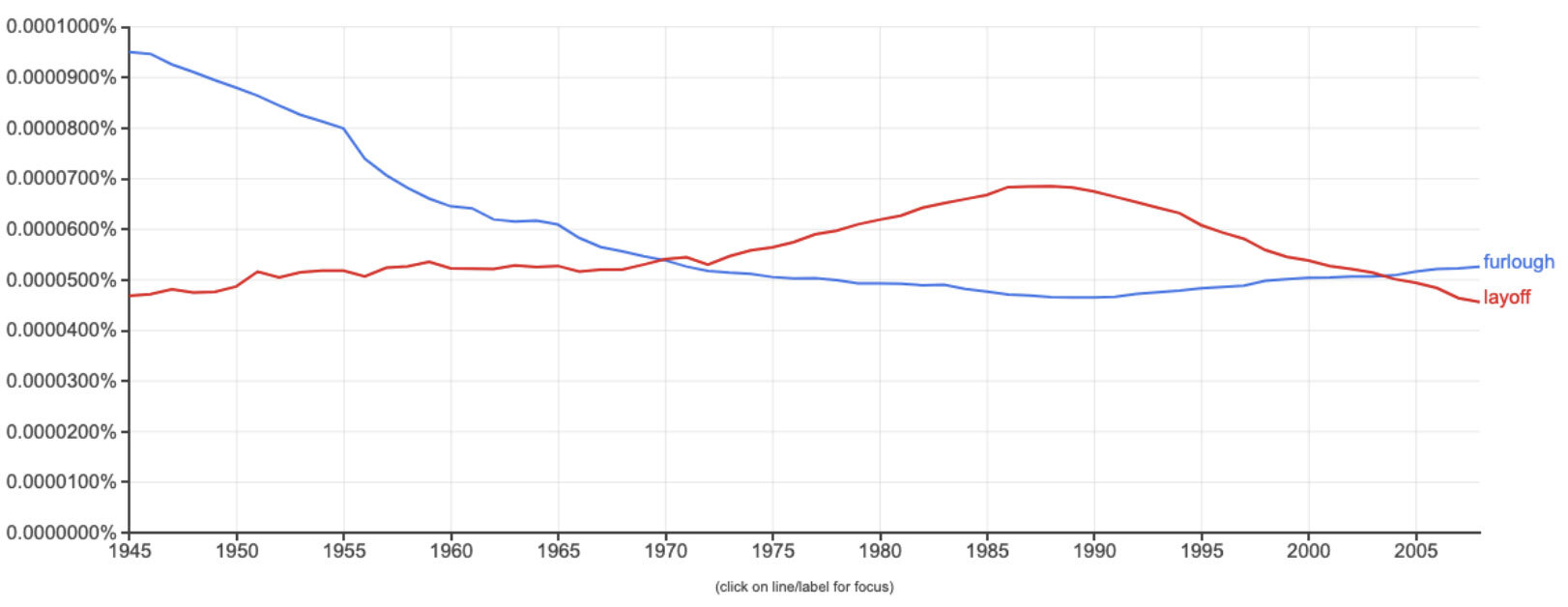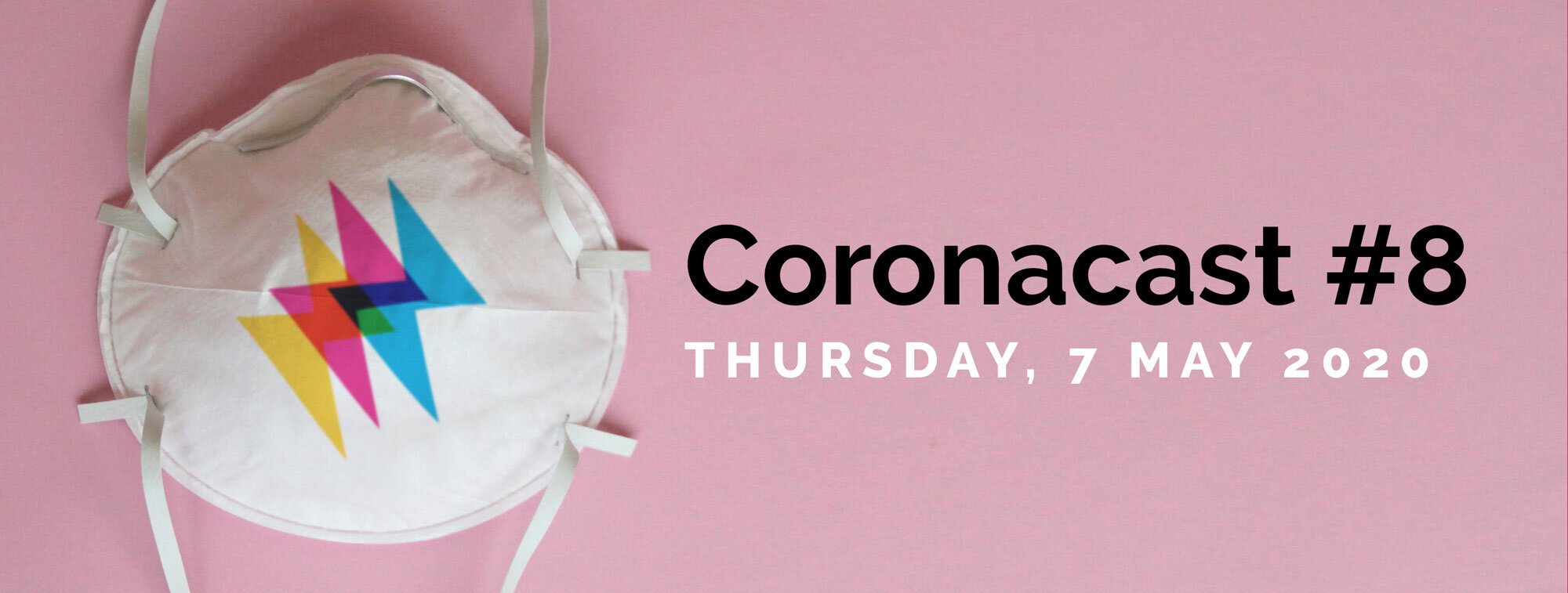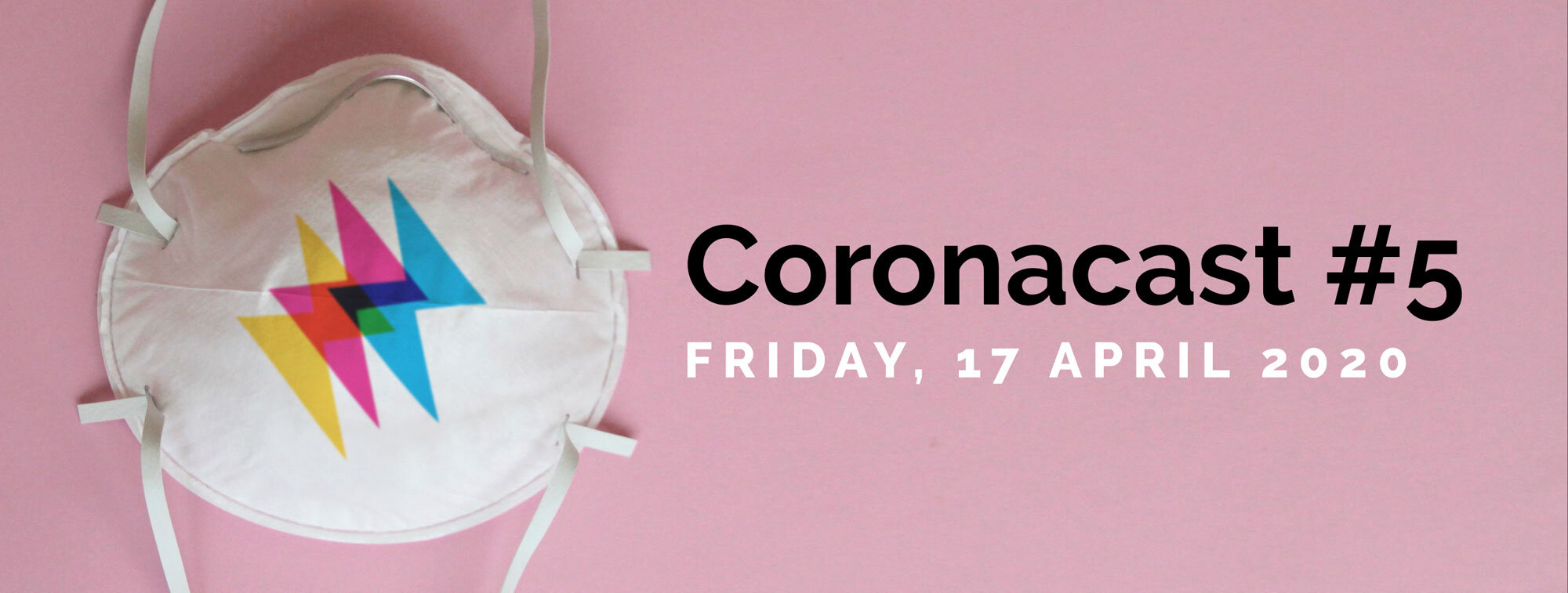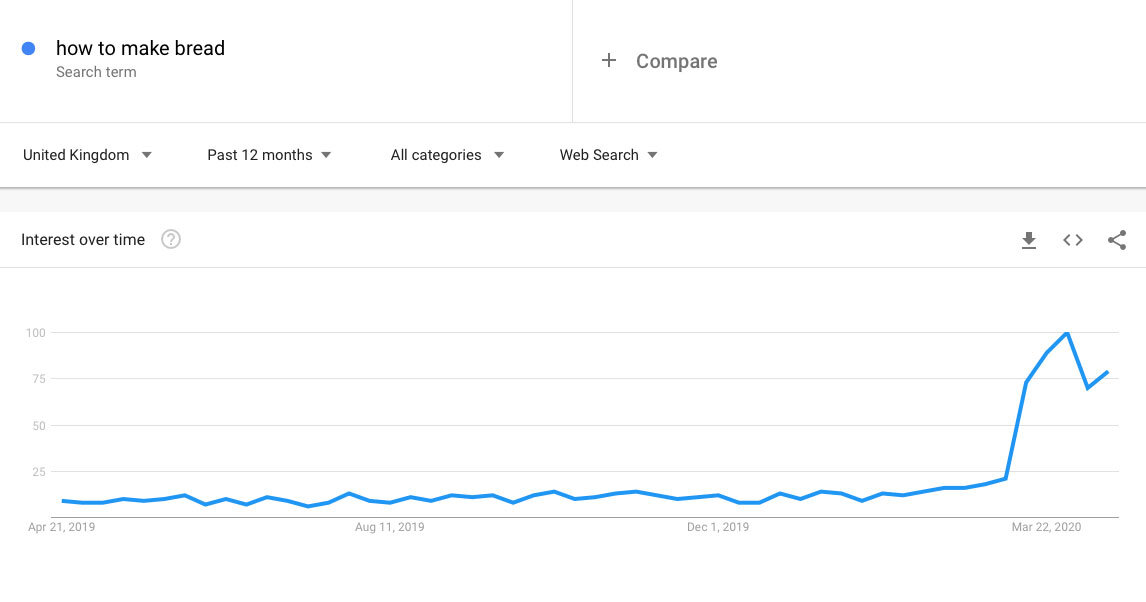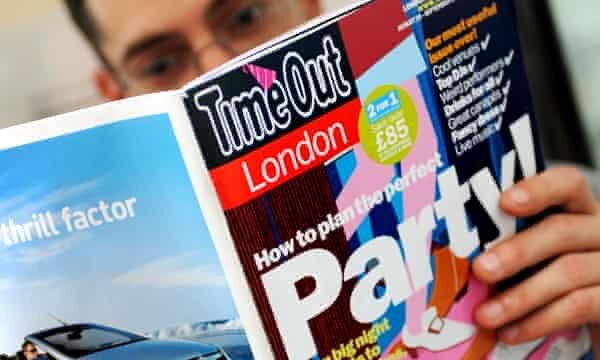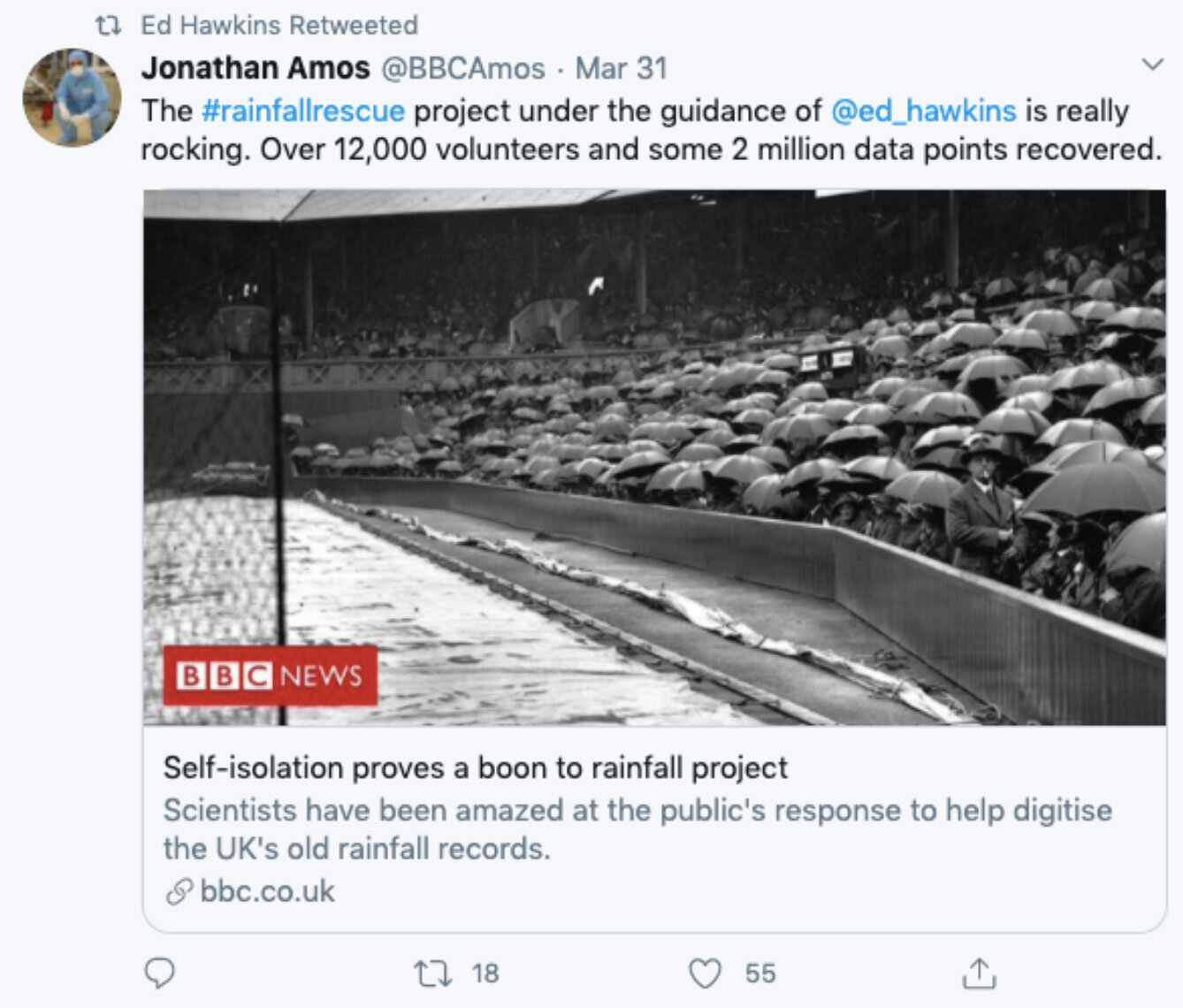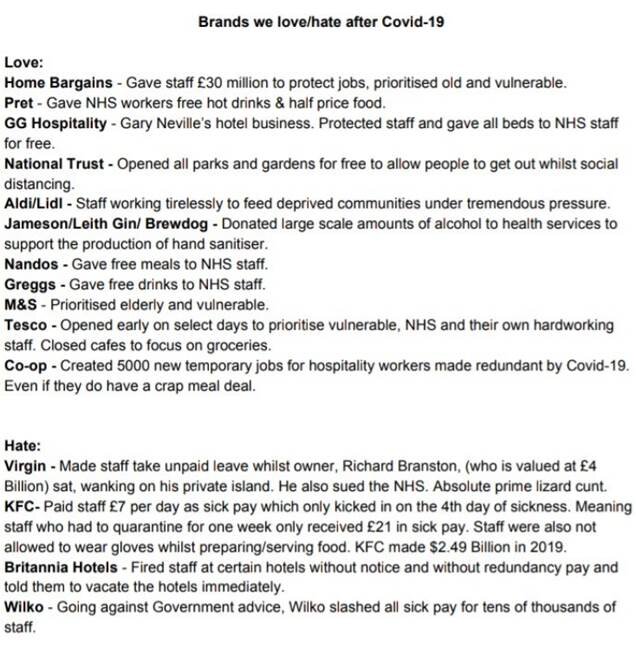Coronacast
By: Colin Cather | Creative Director
Weekly insights on how the media is changing and reacting in light of the COVID-19 pandemic.
Coronacast #12
Friday, 5 June 2020
Here’s our twelfth weekly bulletin, counting the brand comms clock-down in the lock-down.
And because the lockdown - as we knew it - has (softly) unlocked, we’re going to make this our last coronacast. We’ll still be writing and publishing insights, as we always did, but we feel we need to switch up, move on and embrace the #newnormal. So this will be a look and reflection of what we think we’ve learned.
It might sound a wee bit philosophical, so we’ll be sure to include a couple of graphs just to keep it real.
The value of values
That’s what we think we’ve learned (or been reminded of) most. Human values, and brand values, are surprisingly enduring through the things we see as big disruptions. That’s why keeping your promise is the source of enduring connection.
Bridges and Fridges
You could say - when in the midst of a crisis - there are two types of humans. ‘Bridges’ will lay down across the burning chasm and help others to safety. ‘Fridges’ will coldly shut the door and their light goes out.
Brands are empowering; they act as connections, signposts and tribal bonds. Brands shouldn’t be fridges (unless they’re Zanussi).
Ch-ch-ch-(un)changes
There have been a lot of sudden changes - a terrible virus has rampaged, and that one topic has dominated the news and conversation.
Many commentators and observers are rushing to catalogue how ‘things will never be the same’ and how we are stepping into the #newnormal.
We believe that surface level things do change - but people themselves change much less, and much more slowly, than that. What drives us, and motivates us, would look very recognisable to an Aztec.
Brands must respond topically, but connect typically (true to their long-lasting values).
Nice to see you
Take the almost immediate escalation of video-calling - that looks like a #newnormal shift; actually it’s the evidence of the enduring human need to see each other.
So just as we couldn’t (in person), we reached for the next best thing. Longer term, it’ll be voice-calls and emails that are more likely to be replaced by our new video-calling habit.
We’ll still get zoom-fatigue and go back to working together IRL, but with some changes. There may be fewer offices and more laptops in cafes. But the human need to be together is very sticky.
Travelling unravelling
Like there’ll undoubtedly be more staycations this year, but really we still crave a trip to Paris or a fortnight in Cancun.
We might say in surveys like this, from Global Web Index, that we’re planning staycations - but the google searches for staycation haven’t exactly spiked.
It shows a reluctance to accept that option, we think.
How-to be helpful
It has been our watchword to brands throughout this time. Our collective need to have questions answered, to be shown ‘how-to’ has always been high, it just got a little higher in these last twelve weeks.
Branded content is at least as old as The Furrow (by tractor brand John Deere) and the Michelin Guide. Brands that created helpful stories that people valued, and made them a little more inclined to prefer their products.
If you’ve been helpful - solving problems, answering questions, giving people a laugh or some much needed mindfulness - then don’t lose the habit.
Goodwill Hunting
Sales for many businesses will have been hit - and hit badly for some.
Short term, brand activations can drive that return to revenue.
The value of a brand is not only measured in its ability to influence sales volume. This is also a time to remind FDs that brands - the strong ones, the ones that invest - provide longer-term returns in at least two other ways.
They command a premium price - reflected in the gross margin - so that each sale provides more revenue than weaker brands, or commodities.
And this value amasses as an asset on the balance sheet. This intangible asset used to have the old-fashioned-sounding name of ‘Goodwill’. Google (or Alphabet Inc) valued theirs at nearly $17Bn.
Goodwill - that’s still a good word for what it represents. Establishing and accumulating that goodwill, by connecting and engaging, by communicating your values, is why we say that “brands grow when their stories flow.”
Stay safe, take care, be helpful, tell stories.
<coronacastoff>
Coronacast #11
Friday, 29 May 2020
Dear all,
Here’s our eleventh weekly bulletin, counting the brand comms clock-down in the lock-down.
This week’s a (fit)bit of a tech special: in the week when the British government launches track and trace we’re having a look at the stats behind some of the apps, platforms, devices and networks who are connecting with us during lockdown, and helping us as restrictions ease.
Even though Barnard Castle has a Specsavers branch, it’s worth noting that there are app-based eyesight tests available, so maybe try those before jumping in your car with your family and heading to a popular tourist spot to check if your vision is okay.
Keeping with the health theme, are you a Stroller, a Spinner or a Scroller?
Strollers...
The fairly sedate practice of dogwalking looks to be snapping at the heels of other fitness trends, and like most fitness trends these days, there’s an app for that.
Pairing going out for a walk with helping others who might have a pent-up pooch at home, the ‘tinder for dogs’ app Borrow My Doggy has seen a huge rise in dog borrower registrations. Owners get some free dogsitting and dogwalking - and borrowers get the companionship without the ownership.
That said, dog ownership has increased dramatically during lockdown; pet insurers report a 78 per cent increase in people registering new animals. Our own google trends glance at searches suggests that the spike in interest has reached new peaks for that most trad breed, the labrador, while newer mashups like the cavapoo are overtaking the pug.
...Spinners…
We’ve talked about the lockdown fitness trends behind bikes already (coronacast #10) so it’s no surprise that the shouty, much-parodied, indoor bike phenomenon of Peloton has upped its cadence.
Subscribers have doubled and its share price has climbed 5%. Peloton is seen by many as a lockdown alternative to gym membership and spin-classes for the wealthy-classes, but some of the other fitness apps that don’t come with its price tag have also shot up.
Searches for Strava - the app for cyclists and runners to track their efforts - have trebled to an astonishing 5-year high, helped by their good work to support the NHS. (And despite reports that it has been used by vigilante strava-police to catch people over-stepping the lockdown rules.)
…Or Scrollers
Sure, a surprising number of us are actually jumping off the sofa to dance and lip sync, but most of us are only exercising our thumbs when on social platforms.
Data from apptopia confirms the global takeoff of TikTok, with ‘time spent / wasted’ on the app doubling in less than twelve months - and is now close behind Snapchat.
They’ve both got a long way to grow to catch Instagram, with nearly 4bn hours a month. Four billion hours. With an estimate of 1 billion monthly active users, that’s an average of almost 4 hours per month.
In fact, surprisingly, the only social app that didn’t beat their own personal best in March was Pinterest.
Still, it has been growing, with Q1 2020 its highest quarter for active users.
And Pinterest publishes great insights from the platform. It has shared its 4 Stages - suggesting we’re at ‘Escapism and Optimism’, beginning to look forward ‘restlessly’.
“People are really hungry, almost on a deep psychological level, to be able to plan and take back tomorrow. We’re seeing an unbelievable resurgence in planning for summer parties and Christmas – because these events are going to have more meaning than ever,” according to its global chief marketing officer Andréa Mallard.
We’re all Callers
All of the video call platforms continue to grow, and battle for dominance in what will undoubtedly remain a lasting habit, long after the Peloton has become a post-lockdown clothes horse.
By most standards, Zoom looks to be the current winner, growing from 10 million to 200 million participants in the 4 months from December 19 to March 20, and replacing ‘Skype’ as the byword for video calling.
The battle for the virtual workplace could still see others, like Google Meet and Workplace, by Facebook, grow their imprint.
It's playing catchup with Slack - but by launching connected hardware innovations like Facebook’s Portal and Oculus it could help bring a certain tangibility to the intangible experience of working apart - if we can get used to collaborating with colleagues in a VR headset.
Other platforms for collaborative working, like Miro (which gives a virtual whiteboard-style canvas) are also growing fast (and will possibly get rolled up into the big guys’ end-to-end platforms.)
Breathalysers
And finally, let's end with some lo-tech analogue innovations. Of course Brewdog have been quick to highlight recent shortcummings by launching their own brand of short-sightedness and tall-tale inducing IPA.
And Burger King have created this brilliant burger concept to help social distancing, by simply adding extra onions.
Whatever you’re doing, strolling, rolling or scrolling - we wish you and everyone you know, the very best - please stay home, protect the NHS, save lives.
Coronacast #10
Friday, 22 May 2020
Here’s our tenth weekly bulletin, counting the brand comms clock-down in the lock-down.
This week we look at whether we’re all heading towards cocoon-y couch potatoes or energetic stars of #hustleporn. Answer: nothing’s ever really so binary, but we’re in marketing so we’re easily seduced by simple stereotypes.
Huddles and Cuddles
IKEA man is always busy and those instantly distinctive instructions have been reassembled into lots of parodies. (One of them was IKEA’s own April Fool which offered completely blank pages for all the blokes who think they don’t need instructions.)
Now for the playful cocooners in lockdown, they’ve given us instructions for making forts from (IKEA) furniture. It’s a perfect brand-personality-meets-topicality idea.
One that they might’ve wished they’d come up with is this: the cuddle curtain. Cute and lovely DIY solution that has had the kinds of media and social shares that any brand would be delighted with.
See also: homemade Lego beehive (we’re on-record as honeybee obsessives here, especially now we’re working with the Rowse brand team.)
Slobs & Strivers
All of those are very striver-y ideas, for people trying to make the most of the lockdown situation. The bad news - according to some analysis by social listening platform Pulsar , is that there was a swing to slobbishness sometime in April. That’s when 20% of us quit pretending we could hustle our way through, and swapped jeans for elasticated waistbands.
Steve Rowe, the boss of M&S might concur. They’re beginning to think they’ll never sell another necktie and sales of non-wired bras have doubled. Search demand shows that loungewear has a March-April peak that’s more than double the most recent Christmas spike, and we’re not even bothering to go smart with our casual anymore.
It doesn’t help the return to striving when Pringles pre-roll their ads on PE with Joe. The ASA gave Kellogg’s (who own Pringles) a rebuke, as Joe Wicks’ youtube channel was focusing on kids’ exercise. Kellogg’s said sorry, they’d only meant to lure the grown-ups who’re trying to get back in shape with their unstoppable big tube of crisps (not their words). Side note: this doesn’t happen when brands earn their stories, or engage with authentic influencer relationships, instead of buying audience access #justsaying #PRingles.
On your bike
One thing that’s set to be a bigger feature of post-lockdown #newnormal is the bike. Sales are right up, and Sadiq Khan is putting new measures in place for London to be friendlier to the two-wheelers. E-bikes are making cycling even more popular for all ages and abilities, as our own pre-covid cycle trends showed.
Still, for all the innovation, the biggest breakthrough would be a cure for helmet hair. We suggest a collaboration between L’Oreal, Boots, and maybe Toni & Guy if you’re listening.
Events
And finally, a shout-out to the strivers who want to to keep themselves working out in the brain gym. Lots of festivals that might have been totally cancelled have switched to online music and talks. Most famously the wonderfully literary Hay Festival, and if we could give a recommendation then this weekend is also Hay’s little fringe festival called How The Light Gets In. Full of ideas, great speakers like Daniel Kahneman and Steven Pinker, normally we find ourselves ducking from tent to tent usually in Welsh rain and mud. This year, we can strive, and still enjoy a little bit of Pringles-on-the-sofa-time.
Unfortunately, you won’t get to meet some of the classic British Festival stereotypes that we observed at Wilderness on our Bottle excursion all those moons ago when we were able to hang out and have fun as a team.
Whatever you’re doing, striving or ‘relaxing’ this bank holiday weekend, we wish you and everyone you know, the very best - please stay home, maybe build a fort out of furniture, have a bike ride, and still protect the wonderful NHS, save lives.
Coronacast #9
Friday, 15 May 2020
Here’s our ninth weekly bulletin, counting the brand comms clock-down in the lock-down.
Marshall McLuhan said “the medium is the message”. What he didn’t mean was “get one of those clairvoyant-kinda mediums to help interpret the message.”
But that’s what lots of people feel about the shift in government comms since Boris spoke to the nation last Sunday. This week let us be your spirit guide as we look at public safety messaging (through an apolitical lens).
Say what?
After much comms industry praise for the clarity of ‘Stay Home...’ there’s been a collective howl of WTF surrounding “Stay Alert…”. Matt Lucas delivered his lovely but agonisingly on-point parody of Boris. Olaf Falafel gave us this [click to see the full animated randomiser in action and choose your own fave].
And Mark Ritson pounced with his own brand of whoop-ass to lament the absence of anyone from our industry’s expertise.
Don’t mess with the NHS
For behaviour change, for health and safety messages, for bold clarity, you still need to think ‘audience’. Protect the NHS is active - sounds like we’re doing something (by doing nothing, just staying at home.) And we all (pretty much) love the NHS.
Thinking about the audience made the ‘Don’t mess with Texas’ campaign a behaviour-change winner. After the failure of years of efforts to persuade, shame, cajole or bully young Texan (men) not to throw trash out their windows on the freeway, someone thought about their motives. One of which was a fiercely protective (and macho) stance about their own Lone Star state versus the rest of the US. Turning the anti-littering message into something the audience themselves might say to an outsider, gave those same dudes a mantra that switched their own behaviour.
Don’t mess with the NHS
For behaviour change, for health and safety messages, for bold clarity, you still need to think ‘audience’. Protect the NHS is active - sounds like we’re doing something (by doing nothing, just staying at home.) And we all (pretty much) love the NHS.
Thinking about the audience made the ‘Don’t mess with Texas’ campaign a behaviour-change winner. After the failure of years of efforts to persuade, shame, cajole or bully young Texan (men) not to throw trash out their windows on the freeway, someone thought about their motives. One of which was a fiercely protective (and macho) stance about their own Lone Star state versus the rest of the US. Turning the anti-littering message into something the audience themselves might say to an outsider, gave those same dudes a mantra that switched their own behaviour.
We’re talking to the elephant, not the rider.
The elephant is the emotional, instinctive, fight-or-flight part of our brains. You can try persuading the rider with lots of rational facts and figures, but if the elephant doesn’t want to change direction, it’s not gonna.
Doesn’t mean the message has to be dumb. Just has to press some of the oldest instinct-buttons we’ve got.
Make it rhyme, so it sticks. Clunk-click-every trip (unfortunately now dominated by the view we have of the messenger, Jimmy Savile) is thought to have saved 50,000 lives.
‘Dumb ways to die’ took South-Park-meets-Itchy-and-Scratchy animations and added a jaunty soundtrack that - in a similar way to ‘Don’t Mess with Texas’ - made Australians rethink their behaviours with classic Aussie gallows-humour.
We think the new phases of covid-messaging would do well to heed some of these lessons.
Old wine in new bottles
Messages, and words themselves, are so important that it takes craft, and thought, to make a few of them work hard.
We’re curious about the use of the (old) word ‘furlough’. A word that was little-used (in the UK) and much more commonplace in the US. Yet it was chosen for the name of the scheme here.
Clearly not accidental - it’s a deliberately new (old) word to emphasise the unusualness of the scheme. To use a more familiar term like ‘layoff’ would be to associate this with economic failure, downturns, British Leyland and the three-day week of the 1970’s.
See the graph from Google Ngram which measures the use of the word in books written in the English language.
Weird words help to accentuate the impermanence of this situation. It’s not like before, and it’s not gonna stay.
“It’s the economy, stupid.”
Bill Clinton, articulate and erudite, was warned by his team on the value of brevity, clarity, simplicity with this now-famous phrase. They hung it in his 1992 presidential campaign headquarters in case Bill was tempted to stray *ahem*.
It was actually one of three (three is often the magic number) messages. Kantar and Millward Brown serve to remind us that the more messages we try to deliver, the less we achieve. Less (or the more grammatically correct ‘fewer’) really is more.
Sins against Syntax
And as a final word, let’s remember that it pays to be a grammar-nerd when you get it wrong, like this.
So for now, until the message is better-crafted, we’re still wishing you, and everyone you know, the very best - stay home, protect the wonderful NHS, save lives.
Coronacast #8
Thursday, 7 May 2020
Here’s our eighth weekly bulletin, counting the brand comms clock-down in the lock-down.
We overdid it on data and graphs last week, so this is almost entirely number-free (apart from the fact we made the mistake of numbering these coronacasts so now we have a reminder of how long we’ve all BEEN IN LOCKDOWN aaaargh.)
Jig-sauce
It’s a joy to see a brand taking hold of our trend data (see coronacast #3 for the surge in traditional games) and finding a way to bring some playful connection between their distinctive attribute and a mini-phenomenon during lockdown.
Here’s Heinz, who for years (like Guinness) have been making a virtue of good-quality equals slowness...offering the world their 570 piece jigsaw that’s completely tommy-k-red colour.
More Craftiness
What next? Well Hobbycraft have their own eyes on the trad making-habit that’s emerging - including a rise in face-mask ingredients like elastic. So what else for other brands?
You could combine craft + beer (oh, hang on - that’s a thing already). OK so the punks at BrewDog could switch from graffiti skills to get everyone yarnbombing; the beautiful labels of Crate IPA would lend themselves nicely to a spot of macrame, and Asahi could get us all trying ikebana or writing a bad lockdown haiku. Or a haiflu. We have more ideas, if any of you want to get in touch. *crickets*
Stay home. Get creative.
— BrewDog (@BrewDog) May 6, 2020
Want to learn how to draw a BrewDog-style sea creature?
Join artist Fisher at our Online Bar tonight for a live art demo 👇🎨🖌https://t.co/u1H5cz7tno pic.twitter.com/MBMoXggB4n
More (Secret) Sauce
The other trend of brand-help is to give away their recipes...like the guys at Toast Ale for one, helping reduce food waste by turning stale bread into beer. McDs have ‘revealed’ the ‘secret’ of the Egg McMuffin (nice headline The Sun) and Wagamama have given away their Katsu secret-sauce in a new how-to video. We’re pretty sure that one is in the Wagamama cookbook that’s decorating the kitchen shelf but that’s not the point. It’s thoughtful, engaging, most of us will probably never do it but we like and share it and we might put them top of our list when we can go back to what we used to take for granted… slurping noodles as the kids threw crayons.
Did they help?
No one is keeping score...or are they? Contrast Hobbycraft with Hobby Lobby in the US.
This is from a site that’s sprung up called Did They Help? - which is trying to do exactly that. It’s crude, simplistic, narrow in sourcing, but it possibly reflects a media-reported scorecard of brands (and people) during the crisis.
The takeout? First of all, actually help (which as this shows, is sometimes nothing more than behaving in line with the values your brand has on that tab of the website and in the annual report). Second, communicate your helpfulness. This second thing might seem like anything ranging from humblebragging to virtue-signalling, but in fact it’s an essential part of the BE-DO-SAY trio of value-driven value-creation. Create positive stories of your authentic actions, and you rack-up brand value (or de-merits, like here).
Pod help us
Podcasts are still an increasing habit, and one that lots of brands have found a good form of deep engaging content to connect with audiences (and that was before we found ourselves WFH in lockdown). Whether you are creating, or curating your own list of recommendeds, this is a good time to go audio.
We like the examples where brands have taken an adjunct to their product and made a podcast that communicates their values and beliefs. Slack have got their Work In Progress podcast. Zendium toothpaste have created little 2 minute podcasts (to accompany the two minutes of brushing we should all do).
Curating lists and publishing your choices says a lot about your brand, even without you investing in making a podcast of your own. Here’s the grown ups at the FT with their top picks for lockdown listening. Compare and contrast with The Spectator and The Independent (clue: the Indie has fewer right-leaning comedians and satirists than the Speccie). What would your brand’s curated list sound like?
And see our own lessons on making a branded podcast, here.
We wish you, and everyone you know, the very best - stay home, protect the wonderful NHS, save lives.
Coronacast #7
Friday, 1 May 2020
Here’s our seventh weekly bulletin, counting the brand comms clock-down in the lock-down. This week is a data-lover’s week, because we love a stat-story, and we love the way a % symbol forms a geeky little pair of spectacles of scrutiny.
(There’s more later on the intersection of emojis and stats 🤓).
First off, we know that lockdown is spurring a domestic surge in making and baking - so let’s start with the internet’s favourite type of data representation, a pie chart.
The serious point about data analysis is that it can be story-worthy in itself (because it tells us something surprising and / or recognisable about ourselves) or, it can spark a creative exploration for brands, a ‘what could that mean for us?’ moment. And, we live in a time of extraordinary access to statistical information.
Going Off-Grid
Electricity demand tells one story of our changing patterns of behaviour. You might think demand would be up, as we all head into lockdown and pop the kettles on and set the oven to pie-making temperature.
In fact, although the pattern/shape of demand is similar, demand overall is down by around 10%, mostly because the big industrial consumers are using less power.
The morning peak is slightly later than usual – probably because, without commutes and schools, we’re all hitting the snooze button.
Where to?
We might not be travelling and commuting (much), but there are signs that we’re thinking about it more. Apple Maps have shared their data on ‘routing requests’ - the amount of ‘searches for directions’ we’re making. And although it inevitably dropped steeply, globally, in early March, those searches are slowly rising again.
Looking at the city level (there are only a few big-city choices to look at) you can see that in Manchester ‘walking’ and ‘driving’ are starting to uplift (but public transport not so much).
Clicks from the sticks
Anecdotally, we might be finding or hearing signs that the internet itself is straining under the weight of demand. In practice, say the experts at Cloudflare, it’s doing just fine - it’s more likely to be that the more we use the internet, the more we notice its glitches.
Cloudflare also has data on where we’re connecting from. Its maps show the exodus from city centres to the ‘burbs. This map of London shows the change in daytime internet usage between Wednesday, February 19, and Wednesday, March 18, before and after large numbers of people started working from home. Red shows a decrease in internet use, surrounded by rings of green, indicating an increase.
When services like Netflix and YouTube told us they were throttling back on their bit-rate, it wasn’t because the internet wasn’t coping. it was a little bit of brand-level virtue-signalling, volunteering to make a change in advance of any problem showed an early bit of corporate citizenship.
Zoom in Tech
Online video, we’re all at it like never before - more people started using Zoom in the first two months of 2020 than in all of 2019.
Stay-at-home entertainment is also booming. Record numbers of people are using Steam, the popular online PC game store. On one recent weekend, more than 24 million players were logged on at the same time, a 25% jump since February.
Many of us have taken our monitors, keyboards and office chairs home to improve our home office. However, once people do start to return, it’s expected we’ll have a new demand for sustainable tech to WFH as a #newnormal. There’s speculation of a completely new product; a home interactive display that would allow people to do all of their tasks from home: re-engineering/brainstorming /scenarios. The display would need to be small, under 32”, with camera, audio and perhaps a button for Zoom. The cost would also need to be low, as it’s thought that users rather than companies may be paying.
Nature Reawakens
There’s a mix of effects for the natural world - carbon emissions are down, air quality is up, some areas are rewilding and certain animal species are benefitting. Road deaths are fewer for hedgehogs and other wild mammals. At the same time, we’re gardening more (but lawnmowers also cut-down the dandelions, an early source of pollen for our fave wildlife species - the honeybee.) One of the lesser known facts may be that bees use smell to detect pollen sources, so air quality improvements also help them find the flowers.
“We are really excited about working with Bottle to raise awareness of our Hives for Lives initiatives. It’s a scheme we are very passionate about and we believe Bottle is the ideal partner to help us amplify communications around this important issue and build our digital footprint. We were really invigorated by the Bottle team’s understanding of our goals, their creativity and passion for our campaign. They have strong credentials in digital, and we are looking forward to putting the plan into action.”
Epidemiomojis
And emojipedia have done their own number-crunching research to find the emojis we are using for the coronavirus. The most correlated are ‘facemask’ and ‘microbe’ - the global language of a global pandemic.
If we could suggest an emoji-idea to conclude every daily briefing, adopting the language of our social convos to those lecterns of Matt Hancock, Rishi Sunak, and the return of Boris Johnson it would be:
We wish you, and everyone you know, the very best - stay home, protect the wonderful NHS, save lives.
Coronacast #6
Friday, 24 April 2020
Here’s our sixth weekly bulletin, counting the brand comms clock-down in the lock-down. Lots of sectors and categories are hit hard - hospitality and travel are two that are really reeling. We’re having a look this week at some of the innovations they are adopting to keep going.
Staycation across the nation
Hotels, pubs, bars and restaurants have felt the shutters come down very suddenly.
Many travel companies (and comms agencies) have begun switching their thinking to a post-lockdown yet socially-distant likelihood, although Knight Frank’s analysis at least forecasts some optimism for UK hotels based on historic recoveries, with an added #staycation element of demand.
Shaun Roy, their head of hotels, said: “We predict that the market will bounce back following the relaxing of travel restrictions and the containment of the virus, leading to a potential full recovery in London and a gradual recovery in the regions as well as an uplift in investment volumes nationally.”
It’s a good time to start talking about the wonders of this sceptred isle to an audience that’s keen to stretch their legs beyond the local Tesco Express. Or how to transform your home into your own domestic travel destination. Hot tub searches are at a high, right now.
The name’s Bond. Dining Bond.
This innovative initiative seems to have started in the US - and we’re now seeing some UK adoption...restaurants selling bonds (like a little gift to yourself) to secure their share of future trade.
The Boisdale restaurant and bar group, which has sites in Belgravia, Mayfair, Canary Wharf and Bishopsgate, is offering bonds for everything from a bottle of Dom Perignon and 30g of Russian Oscietra Caviar for £169.50 (normally £348) The bonds, which range from £39.50 to £1,500, can be redeemed after ‘victory over corona day’ and up to a year afterwards.
Hmm. Maybe it’s a thing that more affordable brands could look into - around the Bottle team we’re sure some McBonds would create more of a McFlurry of interest.
Fly me to the living room
Some airlines are getting a bad rep (although it’s completely consistent with Ryanair’s persona to be a doggedly cost-conscious and cost-cutting outfit, it’s more jarring for the Virgin brand to see Sir Richard looking for bailouts).
We liked this switcheroo from previously unknown Russian airline S7 who is offering air miles for people to stay at home. In order to get the miles, you will have to be a member of the airline’s loyalty programme, and click the dedicated “I’m home” button every day.
And we love this TikTok trend to stage your own first-class flight from the discomfort of your own laundry room.
¿Dónde está la agencia de relaciones públicas digital más cercana?
Any brands associated with travel could take advantage of the surge in interest to learn during lockdown. We might not be going anywhere, but we’re keener than ever to finally break the British monolingual reputation of speaking louder and waving our arms to communicate abroad.
There are lots of travel related content ideas here - not just lingo skills, but photography and painting. (Our own Laura added a good photography how-to this week too)
At Bottle we’re all still well, WFH and finding new ideas for stories for all our clients - because now more than ever, brands grow when their stories flow. Here’s a word from Rekha at CABA, one of our clients:
‘We recognised that our PR and marketing strategies couldn't continue with a business as usual approach, during this time. We’ve been working closely with Bottle to ensure our PR remains sensitive and relevant to the crisis that everyone is facing. The content they have produced has been pertinent and has included advice-led tips and resources which are proving to be helpful and appreciated by our audience and the media. We have experienced a significant uplift in the amount of coverage we have received and have secured a number of reactive opportunities within national and trade titles.’
We wish you, and everyone you know, the very best - stay home, protect the wonderful NHS, save lives.
Coronacast #5
Friday, 17 April 2020
Here’s our fifth weekly bulletin, counting the brand comms clock-down in the lock-down. (We’re really trying to avoid an opening line cliche now we’ve seen THAT poem...have a look at the last story, below.)
We wish you, and everyone you know, the very best - at Bottle we’re all still well, WFH and WFH (workin’ flippin’ hard). Here are some little insights and top tips we’ve corralled for you, this week.
Locked down, likes up
Most of the time, working for brands, we’re looking for influencers who strike a balance of aspiration and inspiration, choosing the degree of campaign goals between the mega-influencers’ reach, and the micro-influencers’ engagement, with a level of authenticity that still means they’re #relatable.
With time spent on social channels spiking during #stayathome, the influencer tactic is potentially even more valuable for brands who plan to invest in their continued relationship.
Breadmaking & circus tricks
Influencer-default is positivity and optimism, which in this lockdown period is reshaping to mildly self-reflective, sanity preservation techniques and nostalgia. But some influencers are pivoting better than others. Many are asking their followers for the steer - do they want escapism or reality?
Covidiots
And then there’s @loganpaul. It is his job to be an idiot, so we shouldn’t be surprised. Still, even by his standards...
i hope everyone is feeling well! it’s so important right now to self quarantine to ensure we aren’t endangering ourselves or anyone who can’t handle this virus 🤍
— Kylie Jenner (@KylieJenner) March 18, 2020
Keeping up with the centenarians
It was reach, trust and relevance that had America’s Surgeon General calling on Kylie Jenner to help with safety messaging (recognising that anyone over 30 is a boomer in the eyes of Gen Z and therefore irrelevant).
“What I really think we need to do [is] get our influencers,” Surgeon General Jerome Adams said on “Good Morning America.” “We need to get Kylie Jenner and social media influencers out there, in helping folks understand that look, this is serious, this is absolutely serious.”
Here in the UK, maybe we still think the authentic heroism of an almost 100 year old decorated veteran still has something to offer. This week’s most inspiring story came from Capt. Tom Moore - someone 78 years older than Kylie. Pluck, and some stiff upper lip can still give eyebrow-pluckers lip-glossers something to aspire to. His £13M fundraising is a story of pure joy, hope and courage.
Case in point
In earned and shared media, the demand for realness - with a smile - is still strong. Case studies of the unfamous and relatable are in demand, like the WFH tips of small business owners like Sabinna in the Metro WFH series.
And we’re seeing journalists requesting more non-Covid stories to give some protein-variety on the media diet, for a news-plate that can otherwise be a little too stodgy.
Charity PRs! I'm looking for strong case study based stories (not coronavirus related!) for @MetroUK_Life. Please drop me an email if you have anything #journorequest
— Laura Abernethy (@LauraJAbernethy) April 2, 2020
This poem is called “First lines of emails I’ve received while quarantining.” pic.twitter.com/4keCqPaO63
— Jessica Salfia (@jessica_salfia) April 11, 2020
First lines of emails
And finally, this poem from a teacher in West Virginia - made up of first lines of emails received during lockdown - is a poignant reminder for all of us to keep our emotions sincere and to avoid the trite and the banal. And - that a simple creative idea can be so shareable.
Best wishes from all of the team; stay home, protect the NHS, save lives.
Coronacast #4
Thursday, 9 April 2020
Here’s our fourth weekly bulletin, looking at the brand comms spiral of all things viral. Where we pick some of the lessons from brands and media and curate what we hope is some inspo that keeps your marketing tingling.
As a sunny easter weekend challenges all of our #stayathomechallenges - at Bottle Remote HQ we’re all still well, WFH and exploiting every shareable technology to do things better. We’re working on a campaign brief and had a ‘wishing’ session in our creative process this week (we don’t do brainstorms), using @trello instead of a wall of post-its and discovered that it’s actually better. Some of the learnings in this #newnormal time will be keepers, we’re sure. Now back to the #marketinglings.
Check your assets
We’ve reviewed and adapted the story plans for all our clients’ social channels, developing fresh help content and playful entertainment and distractions from the relentless news of covid. The graph is just one of our client accounts and shows the dramatic shift in reach and engagement if you get things right.
As you review your opportunities to be engagingly helpful as a brand, Coke did a simple thing. One of their assets is their reach - in social - and so they’ve generously given it over to causes and charitable groups (Coca-Cola is all about sharing, right?).
The fizzy drinks giant has turned over Twitter, Facebook and Instagram to outside organisations including the American Red Cross, Boys & Girls Club, Feeding America, Salvation Army. The channels “have large audiences and we felt the Coca-Cola brand could use its reach to help and support communities and organizations,” a Cokeswoman-spokeswoman said.
Shake your ass(ets)
TikTok is the 6th largest social platform, and it’s dancing its way up the usage ladder. Stay at home is a time for challenging each other, more than ever, and TikTok was made for it. Even before covid, branded hashtag challenges seemed to be the most popular approach for brands on TikTok. Several musicians and companies like the NFL, Sunsilk, and Universal Pictures have run campaigns.
These campaigns encourage users to create videos around a specific hashtag, often using a specific song or set of dance moves. As TikTok points out, the baked-in virality of challenges may be why they’re favoured: 35% of users have participated in one. Some 16% of all videos on the platform are tied to hashtag challenges.
Now P&G’s #DistanceDance - led by 15-year-old influencer Charli D’Amelio - has had billions of TikTok views. It started as a response to a request from the Governor of Ohio to find a way to get Gen Z to abide by social-distancing orders has spread well beyond Ohio, spawning a #DistanceDance TikTok video that’s generated 8.7 billion views to date globally and 1.7 million response videos.
Hoe-Kay Boomer
Not every brand is going to be relevant to Gen Z, so if dance crazes aren’t your thing, then gardening is pretty big right now. M&S will have been planning their Little Garden series for a while, but their collab with the Skinny Jeans Gardener is super-timely, and gets lots more earned media than it might’ve in other times.
Changing identity
Lots of brands (or just guerilla creatives) have been bringing the distancing message into their identities, as the Audi rings move apart and the Colonel leaves KFC to fry chicken from home, so we’ve taken our own lightning bolts - the three teams who work to catch lightning in a bottle, and given them a our own #stayhomesavelives gif.
Where’s the charts?
We’ve been a little light on the graphs this time, so here’s one that says it all.
And finally, here’s a word from the team at Piaggio UK - one of our newest and nippiest clients for iconic brands ranging from Vespa to Moto Guzzi - on why social matters right now, for them:
"Our products are technical and emotive, and at a time when people aren’t visiting dealerships, maintaining positive engagement with our audience becomes even more crucial. Social media and digital engagement are key tools to achieve this aim because they allow us to have meaningful interactions with customers who we might otherwise be prevented from conversing with. Particularly now, social is also vital for helping to bang our drum by keeping our brand and product stories alive."
Best wishes from all of the team; stay home, protect the NHS, save lives.
Coronacast #3
Friday, 3 April 2020
Here’s our third weekly bulletin, looking at the brand comms spiral of all things viral. (There’s more on the power of rhymes, below, in case that one made you ready to go.)
And a quick update from Bottle Remote HQ - we’re all still well and keeping fit with the HIIT style agility training of being a ⚡️ digital comms agency during covid-19. Our designers are loving their newly kitted out home-studios and sharing their tips.
Read (watch, stream, share) all about it
What’re we doing more of? The news. Who would dare be Anti-Auntie after this? All news consumption is up, hugely, and across all age groups (although the mix of sources does vary). BBC, Sky and The Guardian are judged the most reliable, in a recent Covid-related survey by Havas Media.
49% of respondents said they are watching more live TV because of the virus, 40% said they are visiting social media more, 32% said they are reading newspapers more often, with 29% of 18 to 24-year-olds and 31% of 25 to 34-year-olds increasing their consumption of newspaper brands.
What we’re all doing less of: Part one
Print - the actual newsPAPER - is under threat like never before. We’re not picking up the Evening Standard at the tube station (they’ve cut their distribution by a third and started delivering to doors) and Time Out has gone online-only and rebranded for now as Time In.
At Bottle we’ve long acknowledged that audiences’ reading habits have undertaken a huge swing to online - that’s part of why Digital PR is our thing - but we are acutely aware that good journalism has to be funded, somehow. License fee, subscriptions, advertising spend, and paywall...we gotta pay for what we value.
Home is where the chart is
What else are we doing more of (based on searches, anyway)? Jigsaws. Home entertainment has definitely boosted Netflix box sets and online gaming. It’s also got us going old skool for board games and traditional puzzles.
Faith Popcorn has long forecasted the mega-trend of ‘cocooning’, well now that’s gone to a whole new level.
You might not be in the knitting-market, but you can think of traditional pastimes and how they relate to your brand, like book clubs and readings?
Be useful: help other people be useful
Brands and organisations are offering audiences lots of playful opportunities to get creative. We love this one from The Getty Museum.
And some of us are looking for ways to be useful as well as creative. Another version of volunteering is Citizen Science. It’s a good time to think about giving audiences a task that benefits scientific progress - charities like Cancer Research UK, and bodies like NASA often use the power of the crowd this way. @ed_hawkins has seen a surge in volunteers for the #rainfallrescue project.
What we’re all doing less of: Part two
For lots of sectors, organic traffic is down - between 10-20% down. Now this chart, from Neil Patel is global traffic, and broad-brush, but it paints a picture that we’ve seen ourselves too. A few sectors - food for example - are seeing a rise. And one of our clients, selling pet food online - has seen a 30% uplift in traffic.
What to do? Here’s a couple - even if your industry as a whole has seen drops in search volume, there’s still the opportunity to use this time wisely to improve your rankings and come out on top when the outbreak is over. Just as the nation is gardening more - then tend to our own ‘gardens’ by investing in the kind of evergreen content onsite that means you will be stronger and more authoritative than your competitors.
And invest in social engagement - social has seen a surge of audience time in this period, so maximise this.
Rhymes of the times
It kinda went out of fashion for a while - the rhyming brand line. Do we hear “Do the Shake N Vac and put the freshness back” and just snigger? “For mash, get Smash” - is that soooo ‘okay Boomer’?
Times like these bring a sharp focus on the need for snappy, catchy messages - whether it’s for public safety or for brands. And there’s lots of evidence that a good old rhyme makes a message not just more memorable, but also better understood.
Some of our faves are here on insta, taking the classic visual style of WW2 propaganda posters, and nailing it with a rhyme.
Finally, we’ve received some lovely feedback from clients on our agility...this one is from Anthony Gore, Head of Marketing at walking sports initiative, Just Get Active:
“We transitioned from encouraging in-person participation to providing useful tips to keep active within the safety of home and offering words of encouragement from our ambassador, John Inverdale. Having this agility has meant that our community, can still find value and support from us at this unsettled time. I’ve really appreciated your team’s proactivity. Thank you.”
Best wishes from all of the team; stay home, protect the NHS, save lives.
Coronacast #2
Friday, 27 March 2020
Here’s our second weekly bulletin, of what we’re seeing and hearing, and how Covid-19 is tilting the media and comms landscape.
First we hope you are all well - staying home, staying safe and helping to protect our NHS (it was such a beautiful noise of national applause at 8pm last night).
At Bottle we’re busy with all our clients’ StoryPlans. We’re catching lightning, and fortunately not catching coronavirus (still all fit and well and no suspected cases of CV).
Switching where possible - and appropriate for the brand - is helping those StoryPlans stay relevant and helping to keep brands positioned in this time.
The guiding watchwords we’re following are:
Stay engaged
People are spending more time - much more time - cocooned at home, and checking social and news media.
Be useful
Information and guides (how-to’s and help content) have never been more important. Not all brands can switch production to ventilators and hand sanitiser, but most can offer support and help. Whether it’s which movies to watch, giving #stayathome challenges, or how to care for your pet when you’re stuck indoors - help can be practical but also entertaining.
For one client, with wellbeing-focused story, we’ve gained 2 national media hits among 21 pieces of coverage and nearly 50 links. All by staying relevant, helpful, and being ready to respond to the Newsroom opportunities.
Don’t push
It’s not the time to push product - audiences look to brands to be both useful and optimistic, but are wary of anything that looks self-serving, insincere and profiteering.
People are making (and sharing) naughty vs nice lists of the brands who are doing good (Dyson, Greggs) and the bad to ugly (Wetherspoons, Sports Direct).
Stay chipper
Audiences want distractions as well as news and knowledge. Make games, entertainment - or offer webinars and live-streams (whether it’s cleaning the elephants’ enclosure at Chester Zoo or How To Throw a Teabag Into A Cup) everyone is looking for some fun challenges to share and new things to learn.
Meme not me-me-me
Everyone’s sharing (#coronamemes 417k posts) and brands can add some cheeky self-awareness by joining in (especially if they’re prepared to have a joke at their own expense…)
It’s a familiar point in these strangest of times - brand-building for the long-term, not sales-messages for the short-term, will be the best comms value we can create.
Best wishes from all of the team,
Natasha
Coronacast #1
Friday, 20 March 2020
We hope you are well and doing ok with all this change.
Bottle HQ is pleased to report that we are all fit and well and no suspected cases of CV. The team switched quickly to our #new normal, which involves constant review StoryPlans, regular changes to angles and tone of our content, supporting clients on CV Comms, and becoming masters of video conferencing.
We thought it would be helpful to share our insights on how the media is changing in light of this pandemic.
The media & journalist requests
Many national journalists have actively requested ‘fun, uplifting stories’ to give a balance to their comms. Relevant ‘help’ stories are working very well.
Trade media are publishing a high proportion of Corona story angles but still seeking thought-leadership too.
Social media
Overall, we’ve seen a big increase in social engagement - ad spend and boosting budgets are going further than usual. This is particularly apparent for our clients who target the older demographic who are now in week two of isolation.
Positive stories, help content and ‘community spirit’ is the current approach and working very well.
General trends
165k #coronamemes 31k #coronavirusmemes on Instagram
One of our favourites on Twitter:
Social listening calculates 1.9m mentions of Corona Virus in the last 30 days (excluding retweets).
This emoji cloud taken from the last 7 days. The ones to the left are older ‘fading’ topics, and the ones closest to the right are trending now. I suspect that by next week, we’ll see a lot of children emojis as the kids are home too.
And brands showing acts of kindness are getting a lot of credit – whether putting the Christmas lights back on to bring some cheer into the neighbourhood, to giving freebies to keyworkers.
Here’s to another week of adjustment as parents take on a new challenge at home.
Let’s keep talking,
Natasha
